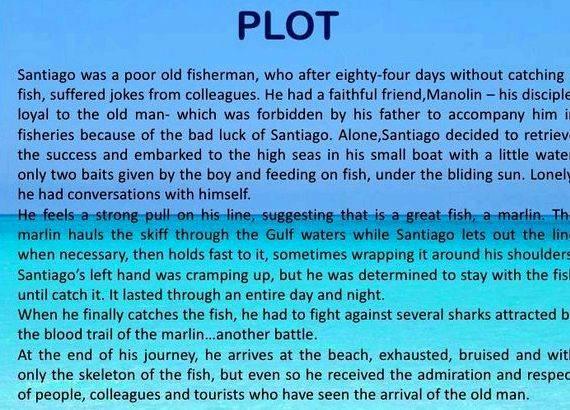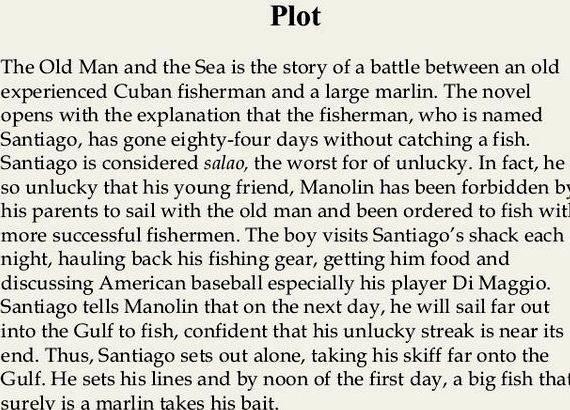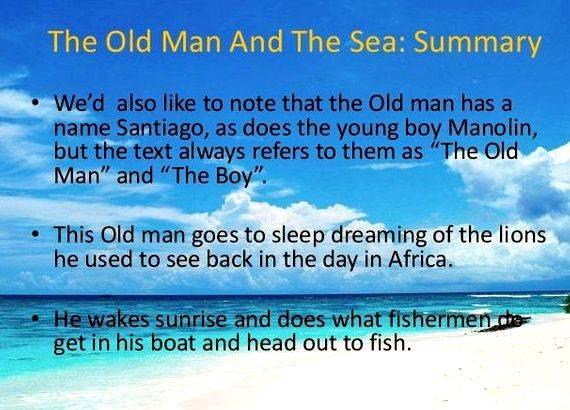In this lesson, we will learn about Ernest Hemingway’s short novel, The Old Man and the Sea. After we discuss the novel’s plot, we will analyze its main symbols and themes. A short quiz will follow.
Background of the Old Man the Sea
Ernest Hemingway was a popular minimalist writer. He was born at the turn of the century in 1899 and wrote up until he committed suicide in 1961. Unlike many writers, he went on a lot of adventures in his life, including working as an ambulance driver during World War I in Italy, a war correspondent during the Spanish Civil War and World War II, and going on an African safari.
Hemingway was a minimalist writer. Minimalism is defined as writing that is whittled down to the basics with the greatest weight of the work put on context rather than the use of extensive descriptive language. During his life, he published several novels and short story collections, but several of his works were published posthumously, too.
The Old Man and the Sea was the last novel Hemingway published before his death. In 1951, Hemingway wrote The Old Man and the Sea in two months, while in Cuba. He was proud of his own work. The slim novel received a lot of critical and commercial success. It was a major factor in Hemingway being awarded the Pulitzer Prize for Fiction in 1953 and the Noble Prize in Literature in 1954. The novel is still widely taught in schools today.
Summary of the Novel
At only 27,000 words, The Old Man and the Sea is a fairly short novel. The main character, Santiago, is a down-on-his-luck Spanish fisherman in Cuba. Everyone looks down on him because it has been so long since he has caught a fish.
His only friend is his apprentice, Manolin, who believes in him even though Manolin’s family wishes he would not.
One day, after a dream about his youth, Santiago takes his boat out farther than any of the other fisherman. He hooks a marlin, but it takes him two nights and two days to battle the fish to the point of exhaustion. When the fish is finally defeated, Santiago is exhausted and wounded (the line having cut into his palms), but the hardest part of the experience is yet to come: he still has to bring the massive fish carcass back to shore.
Santiago starts sailing home, but the bleeding fish carcass, which he has roped to the side of the boat, attracts sharks. Santiago battles the sharks unsuccessfully. There are too many of them and they eat the flesh off the fish. When Santiago finally makes it back home with the skeleton, he leaves the skeleton by the boat and carries the mast of the boat back to his home. Once home, he collapses in bed and falls asleep.
Meanwhile, the villagers see the skeleton and are impressed by its length (18 feet). Manolin, relieved that Santiago is safe again, makes plans with him to go fishing together. Santiago falls back asleep and dreams the same dream that prompted him to go fishing in the first place.
Symbolism in The Old Man the Sea
Hemingway definitely used symbolism in his books. He mentioned how each item in The Old Man and the Sea (the fish, for example) has two levels: the literal (the fish) and a deeper meaning.

The marlin is one of the biggest symbols in The Old Man and the Sea. The marlin is, of course, first and foremost, a fish. As a fish, it has an important role in the book. Santiago, a fisherman, has experienced social isolation because of his inability to perform his job and catch a single fish. Everyone else views him as bad luck. Santiago could have just caught a fish and then gone back to shore immediately. Instead, he wrestles with the fish for two days and two nights and is wounded in the process. He speaks to the fish and considers it a worthy opponent.
Even though he is determined to catch the marlin, he regrets the necessity, since he respects this particular fish so much because of how hard it struggles. By putting these associations on the fish, Santiago elevates it to the status of a symbol. It is no longer just a fish, but also symbolizes his triumph and rebirth as a respected fisherman.
Santiago has a completely different attitude toward the marlin and the sharks. While he respects the marlin as a worthwhile opponent, the sharks use their numbers and ferociousness to overcome Santiago. They are merely predators attracted by the blood in the water. In many ways, the sharks are a symbol for the other fishermen who think Santiago is bad luck because it has been so long since he caught a fish. They are not worthy of respect from either Santiago or the reader.
Themes
There are many themes in Old Man and the Sea. As a minimalist author, Hemingway had a knack for saying a lot even while using only a few words.
The theme of struggle shows up in several ways in Ernest Hemingway’s novel. Santiago struggles socially because the other fishermen believe he is bad luck. He also struggles to perform his job. As a fisherman, he is supposed to catch fish, but at the beginning of the novel, it has been almost three months since he caught his last fish.
Unlock Content
Earning College Credit
Did you know We have over 49 college courses that prepare you to earn credit by exam that is accepted by over 2,000 colleges and universities. You can test out of the first two years of college and save thousands off your degree. Anyone can earn credit-by-exam regardless of age or education level.
Transferring credit to the school of your choice
Not sure what college you want to attend yet? Study.com has thousands of articles about every imaginable degree, area of study and career path that can help you find the school that’s right for you.
Research Schools, Degrees Careers
Get the unbiased info you need to find the right school.






 Writing your life philosophy speech
Writing your life philosophy speech Myp science criteria rubric for writing
Myp science criteria rubric for writing Gheens academy on demand writing unit
Gheens academy on demand writing unit Writing a story about my life
Writing a story about my life Manchester metropolitan university phd by published work creative writing
Manchester metropolitan university phd by published work creative writing






